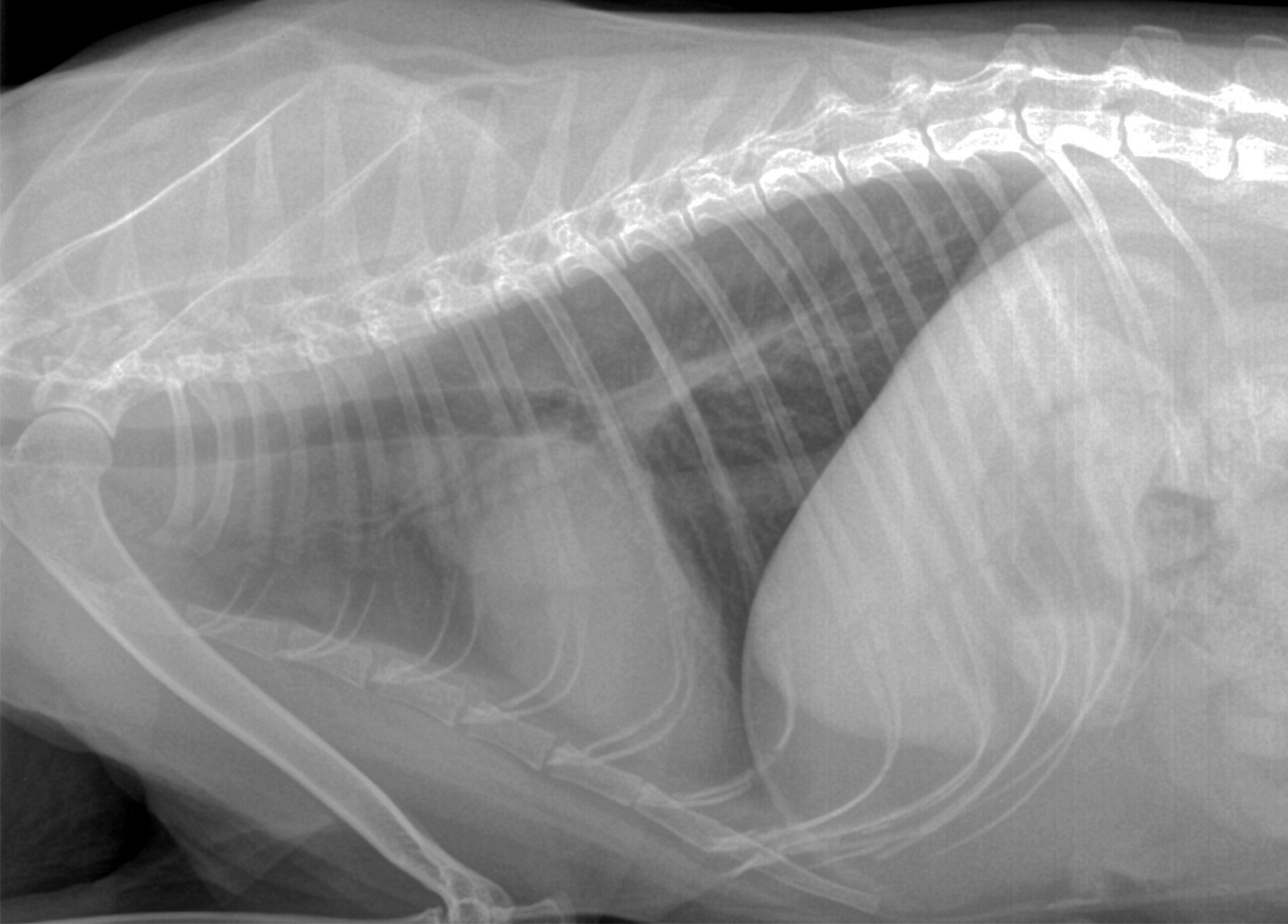
Leo
 Case Background
Case Background
Age: 11 years old
Sex: Male, Castrated
Breed: Domestic Long Hair
Weight: 4.6 kg (10.2 lbs)
Reason for Visit: Adopted as an adult cat 12 months previously. He is reportedly asymptomatic at home. He seems to have some difficulty eating and a dental procedure was recommended. Physical examination revealed a heart murmur and Leo was referred for evaluation prior to his dental procedure.
Medications: None
 Clinical History
Clinical History
Please review Leo’s clinical history.
Attitude/Demeanor: Quiet, alert, responsive
Coughing: No coughing
Abnormal Respirations: None
Exercise Intolerance: Normal
Sleep Patterns: Normal
Weight Change (loss or gain): Weight loss is reported over the past 12 months
Appetite: Reduced possibly related to dental disease
Usual Diet: Science Diet® Adult Maintenance, kibble
Vomiting: Uncommonly vomits hairballs
Diarrhea: None
Syncope: None
Change in Urinary Habits: None
Change in Drinking Habits: None
Other Symptoms or Signs: None
 Physical Exam - General
Physical Exam - General
Please review the results of Leo’s physical exam.
Body Condition: Thin – BCS 4/9
Attitude: Quiet, alert, responsive
Mobility | Gait: Normal
Posture: Normal
Hydration: Normal
Body Temperature: 100.2 F
Arterial pulse – rate, regularity, intensity: 180 bpm, infrequent arrhythmia detected with pulse deficits
Rate & Respiratory Effort: 24 breaths per minute, normal
Mucous Membranes – Color & CRT: Normal color and CRT
Jugular Venous Pulse & Pressure: Normal, no evidence of jugular venous distension
Abdominal Palpatation: Normal
Lymph Nodes: Normal
Oral Cavity: Diffuse periodontal disease is identified
Other abnormalities: None
 Physical Exam - Auscultation
Physical Exam - Auscultation
Let’s auscult Leo’s heart
Listen to Leo’s heart Physical Exam - Differential Diagnosis
Physical Exam - Differential Diagnosis
- High (could explain most or all of the signs)
- Possible (less likely to explain most of the signs)
- Unlikely
 Diagnostic Test Selection
Diagnostic Test Selection
 Blood Pressure
Blood Pressure
Diastolic Blood Pressure: Not available for this case
Mean Blood Pressure: Not available for this caseConsensus Statements of the American College of Veterinary Internal Medicine (ACVIM) provides the veterinary community with up-to-date information on the pathophysiology, diagnosis, and treatment of clinically important animal diseases. In 2018, ACVIM published guidelines for the Identification, Evaluation, and Management of Systemic Hypertension in Dogs and Cats in the the Journal of Veterinary Internal Medicine.Click here to view and download a PDF of the ACVIM Consensus Statement, Guidelines for the Identification, Evaluation, and Management of Systemic Hypertension in Dogs and Cats.
 Radiographs
Radiographs
Please review Leo’s radiographs
Click here for Leo’s radiograph viewer (measure VHS and VLAS here) View the right lateral radiograph Clinical Labs
Clinical Labs
Please review Leo’s lab results
SERUM CHEMISTRIES
BUN: 36 mg/dL Normal: 15-33 mg/dLCreatinine: 1.5 mg/dL Normal: 0.9 – 2.1 mg/dL
Sodium: 153 mm0l/L Normal:146 – 158 mm0l/L
Potassium: 4.9 mm0l/L Normal: 3.4 – 5.2 mm0l/L
Chloride: 120 mm0l/L Normal: 110 – 125 mm0l/L
ALT: 33 IU/L Normal: 25 – 145 IU/L
ALP: 28 IU/L Normal: 10 – 79 IU/L
HEARTWORM
Heartworm Test Results: Not performedURINALYSIS
Urinalysis – USG: 1.018Urinalysis – Protein: Negative
Urinalysis – Biochemical: Not Done
Urinalysis – Sediment Evaluation: Negative
CBC
White Blood Cells: 11.3 K/microLRed Blood Cells: 8.12 M/microL
Platelets: 144 K/microL, scanning reveals clumping with adequate platelet numbers.
Thyroid Level: 2.5 mg/dL
 Echocardiography
Echocardiography
Please review the results of Leo’s echo.
Please view the videos and interpretations that follow.
Click here to watch Leo's LV right sided short axis viewLV chamber size and thickness Symmetrical left ventricular concentric hypertrophy, left ventricular papillary muscle thickening and normal systolic function.
Left atrial size Normal left atrial size.
LVIDd & LVIDs Diastole (1.61 cm); Systole (0.70 cm).
LV shortening fraction 56.5%.
RA, RV and Pulmonary Artery Subjectively normal.
Effusions No effusions visualized.
Color Flow Results Systolic anterior motion of the mitral valve was present producing left ventricular outflow tract obstruction and mitral insufficiency. There was no visible right ventricular outflow tract obstruction.
Spectral Doppler Results The right ventricular outflow tract velocity was normal at 1.2 m/s (120 cm/s). the left ventricular outflow tract velocity was elevated at approximately 5 m/s (500 cm/s). This velocity is converted to a pressure gradient using the modified Bernoulli equation (4v2). So Leo’s velocity of 5 m/s translates to a left ventricular outflow tract gradient of 100 mmHg.
 ECG
ECG
Please review Leo’s ECG
Click here for Leo's ECG results
 Diagnosis & Treatment
Diagnosis & Treatment
You’re ready to form a diagnosis and treatment plan for Leo! Please select your answer to each question below.
 Follow Up
Follow Up
 Post Test - CE
Post Test - CE
Please answer the following questions.
 RACE Certification
RACE Certification
RACE Certification
Fill out the following form in order to receive your certificate.




